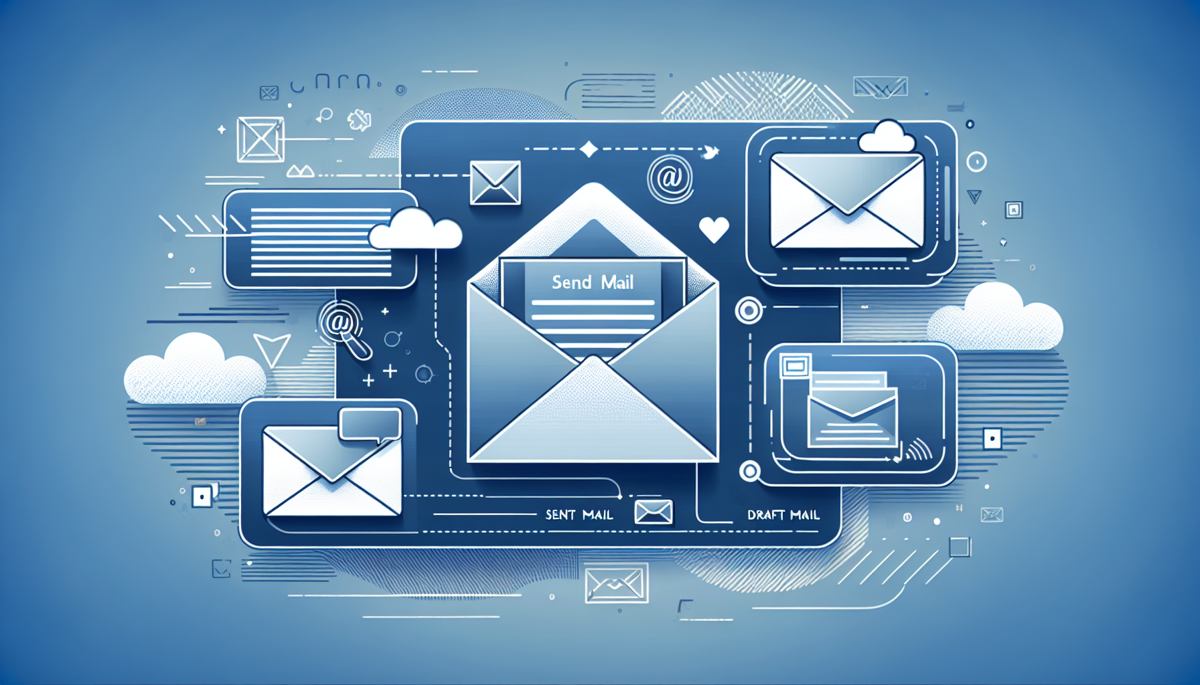How to choose the best email format

In today’s digital communication era, the choice of email format plays a pivotal role in crafting effective, engaging messages. Whether you’re an affiliate marketer, business owner, or content creator, selecting the right format can significantly impact how your recipients perceive and interact with your emails. With the vast number of options available, it can be daunting to decide which one aligns best with your communication needs and strategic goals.
The two most prevalent choices you’re likely to encounter are HTML and rich-text email formats. Each comes with its own set of advantages and challenges, and their effectiveness can vary based on your specific objectives.
HTML emails are renowned for their rich design elements including images, hyperlinks, and diverse layouts. They offer a visually captivating experience and can provide valuable data insights through tracking features—making them ideal for engaging audiences with interactive content.
In contrast, rich-text formats emphasize simplicity and clarity, stripping away complex design elements to focus on straightforward textual content. They are easier to craft and often require significantly less technical prowess, which can be a boon for marketers prioritizing efficiency and avoiding spam triggers.
As you navigate the intricacies of choosing an email format, it’s crucial to balance these options against your overarching goals such as user experience, deliverability, and engagement rates.
For marketers seeking a robust solution that combines ease of use with powerful capabilities, GetResponse offers a comprehensive platform that not only allows you to draft emails in various formats but also integrates marketing automation, content monetization through online courses, and paid newsletters. With its seamless interface, GetResponse provides a free trial for those eager to explore these features. Leverage such tools to refine your strategy and ensure your email communications resonate with your audience.
Explaining HTML Email Format
In the realm of email format options, the HTML email stands out for its rich design capability. HTML emails offer a myriad of design elements that enhance the visual appeal of your messages. These include not just plain text, but also images, hyperlinks, and varied layouts, all integrated to make your emails both attractive and engaging.
Design Flexibility and Visual Appeal
One of the most significant advantages of using the HTML email format is the ability to showcase your brand in a visually appealing way. With HTML emails, you can incorporate brand colors, logos, and bespoke design elements that capture your audience’s attention. This format also allows for creative layout designs that align with your brand’s identity, making it easier to stand out in crowded inboxes.
Enhanced Tracking Capabilities
Beyond aesthetics, HTML emails offer superior tracking capabilities. By incorporating tracking pixels or embedded scripts, you can gather vital data such as open rates, click-through rates, and even how long recipients engage with your content. These insights are pivotal for refining your email strategy and enhancing future campaigns.
Potential Challenges and Considerations
However, HTML emails are not without their challenges. They often demand more time and resources in the creation and testing phases, as the rich elements must render properly across diverse email clients and devices. The intricate designs require a keen eye for detail and some technical know-how to ensure they display as intended.
Moreover, the same complexity that allows for stunning visual engagement might contribute to deliverability issues, such as being flagged as spam. Complex HTML code can sometimes trigger email filters, meaning your message might not reach the intended inbox.
Impact on Communications
When considering whether the HTML email format is suitable for your objectives, weigh its potential to both enhance and hinder your communication efforts. If visual storytelling and detailed analytics are high priorities for your campaigns, HTML can offer significant advantages. However, it’s crucial to balance design flair with simplicity and ensure technical precision to avoid pitfalls.
Ultimately, understanding how HTML email format can both aid and obstruct your communications will empower you to make informed decisions, aligning your email design with your broader business goals and audience expectations.
Explaining Rich-Text Email Format
In today’s fast-paced digital landscape, the choice of email format can significantly impact the effectiveness of your communication strategy. A popular option for many is the rich-text email format, which prioritizes simplicity and clarity over complex design.
What is Rich-Text Email Format?
Rich-text emails offer a straightforward approach to email creation, focusing on clear and concise textual content without the use of elaborate design elements. This format strips away the intricate details and allows your message to stand out in its purest form. Thanks to its simplicity, rich-text email is both easier to create and requires less technical expertise compared to its more visually intricate counterpart, HTML.
Advantages of Rich-Text Email Format
The rich-text format shines in its ability to convey straightforward messages efficiently. It’s a great choice for those who need to deliver essential information without the distraction of graphics, flashy layouts, or complex structures. This format is inherently lightweight, meaning it often bypasses spam filters more effectively than HTML emails, ensuring that your messages are delivered right into your recipients’ inboxes.
Additionally, this format is ideal for individuals or companies that want to maintain a professional and personal tone. Without the bells and whistles of HTML emails, rich-text emails often feel more personal and can strengthen the connection between the sender and recipient.
Limitations of Rich-Text Email Format
While rich-text emails are simpler to craft, they come with a set of limitations. The absence of images, varied layouts, and interactive elements can make these emails less visually engaging. This constraint also means there are fewer opportunities for brand customization, which might be a setback if you aim to create a distinct visual identity through your emails.
However, if your priority is to share clear, digestible information directly, and with fewer risks of landing in the spam folder, the rich-text format is a reliable choice. By focusing solely on the content, you can ensure that the message doesn’t get lost in translation.
Getting More Out of Your Email Strategy
For those looking to grow their business while maintaining simplicity in email formats, platforms like GetResponse offer comprehensive solutions. Not only can you create emails in various formats, but you can also automate marketing efforts and monetize your content—all in one place. With features that allow you to send emails, automate marketing, offer online courses, and distribute paid newsletters, GetResponse helps in seamlessly integrating various aspects of email marketing. By taking advantage of their free trial, you can explore these capabilities firsthand and see how it aligns with your email strategy.
In summary, while rich-text email formats may lack the allure of visual engagement, they are powerful tools for delivering clear messages effectively. When integrating these with platforms that offer broader marketing functionalities, you can achieve a harmonious balance between simplicity and business growth.
Pros and Cons: HTML vs. Rich-Text Email Formats
Choosing the appropriate email format can significantly affect your communication outcomes, influencing both user experience and deliverability. Below, we thoroughly examine the benefits and limitations of HTML and rich-text emails, providing essential insights to aid in making an informed decision.
HTML Email Format: Pros and Cons
Pros:
- Visual Appeal: HTML emails allow for aesthetic enhancements with rich design elements, including images, colors, and varied layouts. This helps in grabbing the recipient’s attention and enhancing engagement.
- Interactive Features: The ability to include hyperlinks and interactive buttons makes email communications dynamic. Such features can lead to increased interaction rates with your audience.
- Tracking and Analytics: Embedded tracking capabilities in HTML emails offer metrics on open rates and click-through rates, facilitating valuable insights into email format performance.
Cons:
- Spam Filters: Complex HTML code, if not properly optimized, may increase the chances of emails being triggered as spam, negatively affecting deliverability.
- Design Complexity: Designing HTML emails often requires more time and resources, as well as technical skills to ensure compatibility across various email clients and devices.
Rich-Text Email Format: Pros and Cons
Pros:
- Simplicity: Rich-text emails prioritize simplicity and clarity, which can make the message more straightforward and easier for recipients to digest without unnecessary distractions.
- Ease of Creation: These emails are easier to create, often requiring less time and technical expertise, making them a practical solution for straightforward communications.
- Reduced Spam Risk: Without complex coding, rich-text emails have a lower chance of being marked as spam, thus potentially improving deliverability.
Cons:
- Limited Visual Appeal: Rich-text emails lack advanced design features, which can make them appear plain and less engaging.
- Branding Restrictions: The inability to incorporate branding elements such as logos and company colors limits opportunities for brand reinforcement within the email.
Aligning with Business Objectives and Audience Needs
Understanding which email format aligns with your business objectives and audience preferences is essential. HTML emails are ideal if your strategy is centered on branding, engagement, and data-driven decision-making. Conversely, if clear-cut communication and ease of readability are your goal, rich-text emails may be the preferable choice. Each format has its own distinct implications for user experience and open rates, thus requiring a strategic approach to selecting the one that best fulfills your organization’s needs.
Conclusion: Choosing the Right Email Format for Your Needs
Selecting the right email format is a critical step towards achieving effective communication and meeting your outreach objectives. This choice directly influences how your message is perceived by your audience and how well it performs in terms of engagement metrics like open rates and click-through rates.
When you opt for an HTML email format, you prioritize visual appeal and detailed tracking capabilities. This format is ideal for campaigns where the design plays a pivotal role in capturing the audience’s attention. HTML emails allow you to incorporate images, varied layouts, and hyperlinks, thus providing a rich and dynamic user experience. However, it’s essential to weigh these benefits against potential challenges, such as the risk of landing in spam folders due to complex code or needing more resources to design these emails.
On the other hand, a rich-text email format focuses on simplicity and clarity. Rich-text emails prioritize straightforward messaging, making them perfect for communications where the message is the star of the show. These emails are easier to create and are less likely to raise spam filters’ red flags. They might not offer the same level of visuals as HTML emails, but their simplicity can sometimes result in a more focused message with less distraction.
Understanding these differences can help you optimize your email strategy to align with your specific business goals and audience preferences. Tailoring your approach enables you to leverage the strengths of each format, ensuring your messages truly resonate with your audience and deliver the desired outcomes.
For marketers looking to streamline their processes and maximize the impact of their email campaigns, platforms like GetResponse offer versatile solutions. GetResponse allows you to write emails in different formats, and combine this with automation and monetization capabilities. Consider exploring their free trial to see how you can grow your business and boost revenue with their comprehensive platform, which seamlessly integrates these elements for an enhanced marketing strategy.
By carefully considering your needs and objectives, and utilizing robust tools like GetResponse, you can craft an email marketing strategy that not only reaches but engages and converts your audience effectively.





